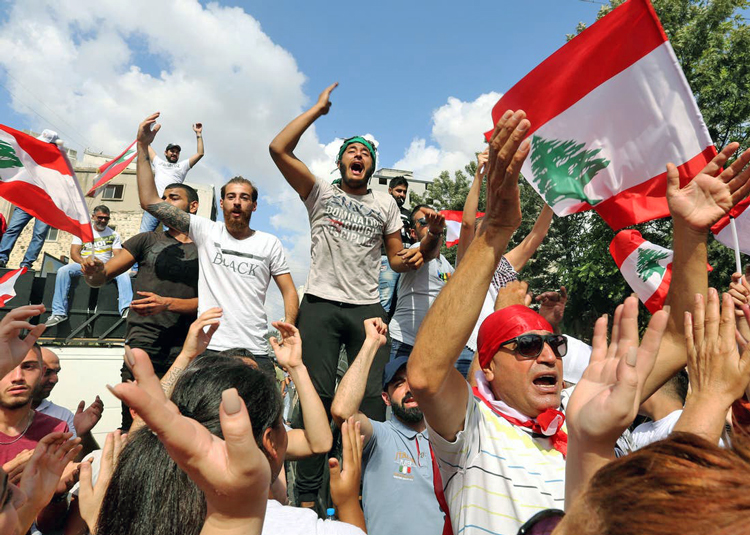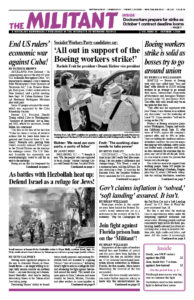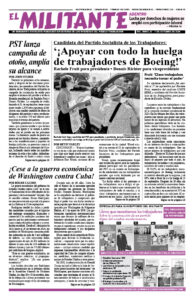Having made significant progress in the war to dismantle Hamas in Gaza, Israeli forces — no longer willing to accept daily missile assaults on northern Israel — are now focusing on Lebanon-based Hezbollah. And they’re dealing devastating blows to the Tehran-allied Jew-hating group.
Destroying Hamas’ ability to launch future deadly pogroms and pushing Hezbollah back are essential to crippling Tehran’s “axis of resistance,” defending Israel’s right to exist as a refuge for Jews and advancing the fight against Jew-hatred around the world. This would also open space in Gaza, Lebanon and more broadly for Jewish, Muslim, Christian and other workers to come together in defense of their class interests.
At the behest of the reactionary bourgeois regime in Iran, Hezbollah began daily attacks on northern Israel, using drones, missiles and anti-tank weapons Oct. 8, the day after Hamas thugs murdered 1,200 people in southern Israel, wounded thousands, took more than 250 hostages and raped and mutilated dozens of women. Oct. 7 was the worst anti-Jewish pogrom since the Nazi-organized Holocaust in World War II.
Hezbollah leader Hassan Nasrallah says he launched the attacks in solidarity with Hamas, and that the attacks will continue until Israel agrees to a cease-fire in Gaza.
As a result, more than 60,000 citizens of Israel — including many Arab citizens — have been evacuated from the north and are unable to return to their homes. Some 26 civilians have been killed there since Oct. 7, along with 22 soldiers.
Israeli counterattacks have killed over 580 Hezbollah members and their allies. On Sept. 17 some 3,000 Hezbollah operatives across the country were wounded and 39 killed when their booby-trapped pagers exploded.
On top of that, an Israeli airstrike Sept. 20 eliminated almost the entire leadership of Hezbollah’s elite Radwan Force, which leads the group’s offensives against Israel, including its commander, Ibrahim Aquil.
Israel to Lebanese civilians: evacuate
Before the latest round of fighting some 80,000 Lebanese civilians left their homes near the Israeli border. Tens of thousands more fled north Sept. 23, after the Israel Defense Forces got the word out to civilians that it planned to take out arms depots, rockets and rocket launchers hidden in homes in the south.
The IDF sent text messages in Arabic, made phone calls and broadcast statements by taking over Lebanese radio transmissions, urging them to leave. “Hezbollah is lying to you and sacrificing you,” one message said. “Its missiles and drones are more valuable and important to it than you are.” Israeli Prime Minister Benjamin Netanyahu told Lebanese there that “once our operation is finished, you can come back safely to your homes.”
On Sept. 23 alone, the Israeli air force carried out 650 sorties, striking over 1,300 targets, the largest attack on Hezbollah since what is now known as the 2006 Second Lebanon War.
In close collaboration with Tehran and with its financing and training, Hamas launched its Oct. 7 pogrom, aiming to terrorize Jews and everyone else in the area — Bedouins, Arabs and workers from abroad. They hoped that taking a large number of hostages would force the release of thousands of Hamas thugs imprisoned in Israel for carrying out terrorist attacks and would sabotage moves by Arab and Muslim regimes to “normalize” diplomatic and economic relations with Israel. They also thought it would advance their long-term goal of destroying Israel and expelling or killing the Jews that live there.
Hezbollah represses working people
Hezbollah thugs — like its allies in Hamas in Gaza and its masters in Tehran — intimidate, assault and murder their opponents. In June, some 20 armed
Hezbollah thugs assaulted journalist Rami Naim in broad daylight in Beirut. “My great crime is having a stance against Hezbollah,” Naim told the media.

But unlike Hamas in Gaza, which smashed its rival Fatah in 2007, Hezbollah has never completely dominated Lebanon, contending with competing bourgeois parties and with a working class that finds ways to assert its interests.
On Oct. 27, 2019, for example, some 170,000 protesters from all religions formed a 105-mile chain linking Lebanon’s north and south. The protest arose out of opposition to tax hikes and called for the government’s resignation.
The Israeli government’s goal is to force Nasrallah to pull Hezbollah back from the border and to end its air attacks, so residents of northern Israel can safely return to their homes. It also aims to degrade Hezbollah’s command structure and military forces to block further attacks.
So far neither Hezbollah nor its “advisers” in Tehran have shown they are prepared for a full-scale war. Israel is “dragging us to a point where we do not wish to go,” Iranian President Masoud Pezeshkian complained on Sept. 23. “There is no winner in warfare.” But responsibility for the widening of the war is on Tehran’s shoulders. It helped plan and fund the Oct. 7 pogrom, pushed Hezbollah to attack northern Israel and continues to drive toward production of nuclear weapons — a deadly threat to Israel.
At the same time, the Joseph Biden administration continues to press Israel to end its war on Hamas before the Jew-hating group is completely dismantled, pull back from its attacks on Hezbollah, and find an “off-ramp” from the fighting.
The U.S. rulers’ concern is not fighting Jew-hatred or defending Israel as a refuge for Jews. Their goal is to gain some stability for U.S. imperialist interests in collaboration with regimes throughout the region.
“A diplomatic solution is still possible,” Biden told the United Nations General Assembly Sept. 24. “In fact, it remains the only path to lasting security to allow the residents from both countries to return to their homes.”
The crisis in the Middle East will be at the center of discussions at the General Assembly, where the U.N.’s leadership itself and a majority of its members have been acting as apologists for Hamas and Hezbollah.


